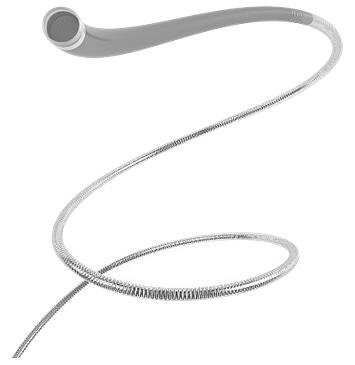On March 1st, Medtronic Japan Co. Ltd. began selling "Rist Radial Access Guide Catheter" a guiding catheter exclusively for a radial artery puncture approach in cerebrovascular treatment. The device enables catheter insertion through the radial artery in the wrist, providing a new treatment access option alongside the femoral artery puncture approach, which is the approach generally used for cerebrovascular endovascular treatment.

© 2024 Medtronic.
There are two representative endovascular treatment methods as follows: transfemoral access (TFA), involving insertion of a catheter through the femoral artery in the thigh; and transradial access (TRA), involving insertion of a catheter through the radial artery in the wrist. Although TFA is less invasive than surgery, it has some clinical issues.
The femoral artery is a large artery that can be punctured relatively easily from the body surface. TFA provides the advantage of being able to insert a large catheter with little difficulty. The femoral artery has a high blood flow; therefore, it takes time to stop bleeding, requiring patients to rest in bed for several hours after surgery. There is also a risk of bleeding complications at the puncture site. Subcutaneous bleeding is difficult to detect on the body surface even if there is a large amount of bleeding, which may become serious, making the postoperative management after TFA treatment difficult.
In contrast, TRA, in which a catheter is punctured through the radial artery, is advantageous because it is easier to achieve hemostasis and no restrictions are observed on movement immediately after surgery. As the radial artery is located in a superficial layer, it is easy to stop bleeding by compressing the bone, leaving little space for a hematoma to form. Achieving hemostasis is simply a matter of wrapping a tourniquet band around the patient's wrist. The patient can return to their room in a wheelchair or may even be able to walk soon thereafter.
No restrictions are observed on the resting position in bed; therefore, the patient can be returned to their room immediately, reducing time spent in the operating room and reducing the burden on caregivers. TRA is expected to reduce the risk of bleeding complications at the puncture site, reduce the burden on patients during surgery, and shorten the length of hospital stay.
Rist is the first guiding catheter specifically designed for TRA in cerebrovascular endovascular treatment. A guiding catheter serves as a scaffold in endovascular treatment, which is performed by delivering a therapeutic device into the guiding catheter.
TRA in cerebrovascular endovascular treatment requires passage through sharply curved blood vessels such as the aortic arch. The problem of conventional guiding catheters is that delivery to the target area is difficult. In contrast, Rist is a catheter that smoothly follows steeply curved blood vessels and has excellent guiding ability that enables its delivery to the target site. Rist is a catheter product that is designed to be difficult to break, maintain the lumen without collapsing (lumen maintenance), and provide support to assist in the operation of therapeutic equipment at bends within the blood vessel.
This article has been translated by JST with permission from The Science News Ltd. (https://sci-news.co.jp/). Unauthorized reproduction of the article and photographs is prohibited.




